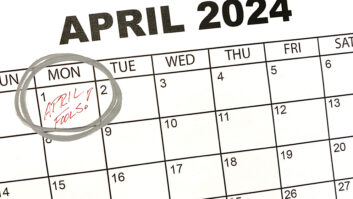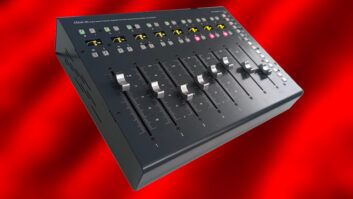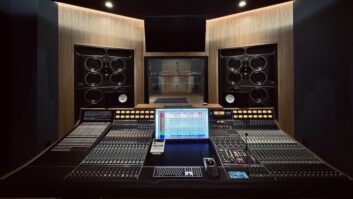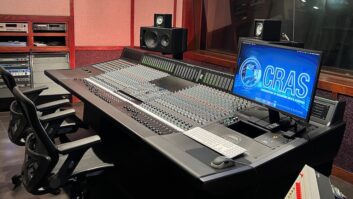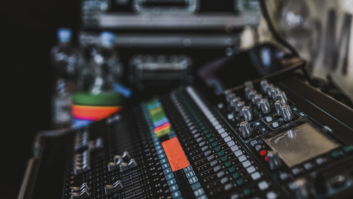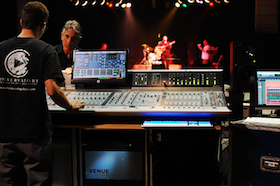
Conservatory of Recording Arts & Sciences instructor Keith Morris working with a student on the Avid D-Show during a live band clinic.
Photo by Robert Brock
By the time this issue of Mix reaches subscribers, the election-year rhetoric about unemployment will have reached a fever pitch. But anyone coming out of audio school knows that job scarcity isn’t news. For the scores of new engineers who enter the market every year, it’s a fact of life to be faced and conquered.
Which begs the question: What do students need to succeed at school and beyond? Where are the jobs for all those grads? Well, with many in the music industry saying the old financial model has turned upside-down—that touring is the new revenue source and physical product is now largely a marketing tool—it seems high time to talk about career and educational opportunities in live sound.
We talked at length with representatives of four of the top U.S. audio education programs that offer a live sound curriculum, asking how they prepare students for careers in show production. Our panel of experts includes Greg Stefus, director of student services and internship coordinator at the Conservatory of Recording Arts & Sciences (cras.edu); Dana Roun (director of audio arts) and Mark Johnson (live sound program manager) from Full Sail University (fullsail.edu); John Scanlon, program director, sound arts and interactive audio, at Ex’pression College for Digital Arts (expression.edu); and John Krogh, chair of music production and contemporary writing at McNally Smith College of Music (mcnallysmith.edu). They offer future live sound engineers an idea of the skills they’ll need in the field, the likelihood of finding gainful employment, and insights into whether or not they’re really cut out for a career on the road.
CAN YOU GET ME A JOB?
How likely is a student entering your program to find employment in his or her field upon graduation?
Stefus: Live sound is one of the more stable areas where there are jobs available for our interns and graduates. In a recording studio, you start as an unpaid intern. You have to serve a lot of coffee before you start any kind of paying career in studio work. In live sound, the economic infrastructure is such that you can go straight from school into a paying job, whether you’re doing corporate audio-visual, working on a sports broadcast or for a club.
Roun: At Full Sail, we take a large amount of job leads for live production. That’s a very broad term—that’s everything from houses of worship to cruise lines to large-scale touring or theaters—but it’s been a growth area for us. Over the past five years, our Show Production graduates have maintained a strong initial employment percentage, ranging from 81 to 90 percent, depending on the year. That’s in part because the live sound industry has a good way of responding to economic challenges. A couple of years ago when things began to flatten out, a lot of major audio providers got more into areas like corporate or boardroom installs or the house-of-worship market. This is an industry that’s been really flexible.
Scanlon: I think there’s so much opportunity in live sound because the live production element has branched out so much. You’ve got presentations with laptops, Bluetoothing iPads, PowerPoint presentations that have audio elements. Not to mention, I’ve never seen as many bands on tour as I do right now. We teach our students to be technically capable of handling almost anything in terms of live audio and visual content so they’ll be sharp when they get out there.
Krogh: In recording studios, there is a culture of apprenticeship where you learn the ropes and come up through the ranks, usually starting with an unpaid internship. But with live sound, there are opportunities to find paid work right out of school. It’s essential that students have a broad view of what those opportunities look like: You might go into mixing front-of-house for bands playing in clubs, but you might also find work in AV installation, on a cruise ship, in corporate boardrooms.

An Ex’pression student works on a Soundcraft SM20 monitor console during an Ex’pression Session with artist The Temper Trap in Meyer Hall at Ex’pression College for Digital Arts.
JACK-OF-ALL-TRADES
Given the premise that job functions in the industry aren’t as segmented as they used to be—front-of-house engineers do remote recording, and audio and video coexist in so many applications, for example—how do you teach students to be ready for everything?
Stefus: In our program, everyone learns everything. Even the student who comes here to make rock ’n’ roll records, at the end of their 30-week program and internship, is also trained in sound reinforcement. We start with a lot of trouble-shooting and maintenance—a firm understanding of electricity and electronics. They take soldering classes. They create and fix gear on the spot. Later, they will be part of productions in our 6,000-square-foot venue, where they’ll mix live performances and record remotely into Pro Tools.

John Scanlon, director of sound arts and interactive audio at Ex’pression College for Digital Arts.
Johnson: By the nature of the industry we serve, we have to teach a broad range. You’re talking about everything from hotel A/V up to large-scale touring and installs, so our courses reflect that. We start with basic audio and electronics, and then introduce show production systems. They learn the corporate and sports broadcasting. Installation technology, audio measurement systems, advanced show production… By the time students get out of here, they definitely have enough experience to start somewhere.
Scanlon: Our Sound Arts program begins with 16 weeks of studio maintenance—everything from wiring to power to digital and analog circuitry to reading schematics. They learn recording engineering in the studio before they get into live sound, where they’ll really be tested in ways they might not be in the studio. In a commercial studio, if something goes wrong, you go get the studio tech. In the live sound world, you’re both. You need to be firm on Ohm’s Law, power requirements, how to pull out cables that aren’t necessarily designed to operate with your speakers and make them work. You have to be a little more of a MacGyver.
Krogh: All of our students learn fundamental engineering skills that help them troubleshoot and work in a variety of situations. The more practice students get with different technologies and facilities, the more confident they are and capable of dealing with whaever they encounter when they leave here. They work on a variety of consoles—Midas, Trident, ICON, SSL—so they’re building a foundation of understanding: “I know that this is how this type of device is supposed to work, so even though this is a brand-new board I haven’t worked with, I intuitively know there should be a way to recall mix settings per song, for example. I can figure that out.”

McNally Smith alumnus Veronica Rodriguez (at right) engineers a remote broadcast for radio station Cities 97. She is part of a 5-person team that’s responsible for all of the audio engineering and IT needs for the ClearChannel office in Minneapolis.
HANDS-ON EXPERIENCE
What type of hands-on experience should students expect to get in school as part of their coursework or an internship?
Stefus: Live sound interns usually start off checking in gear. They’re the ones who unload the trucks, clean equipment, check it to make sure it’s operating properly. Even if they’re not operating gear right away, they’re learning how gear operates, and this is the type of work they’ll do at the entry level if they were hired at that facility. We’re training students to be as employable as possible.
Johnson: We have something here called Show Pro Club that’s open to all students in the Show Production degree program. Students sign up to crew different events on campus, as well as off-campus shows at places like the Hard Rock or the House of Blues. Another example of what we offer: Last week we held a live mixing seminar in our live production facility, Full Sail Live, hosted by Meyer Sound and featuring Buford Jones, who’s mixed so many big tours [David Bowie, Eric Clapton, Pink Floyd, Faith Hill, etc.]. Not only did he go over mixing concepts, it was also a chance for students to be part of a production staff—manning spots, camera positions, technical director, assisting at the monitor mix position. Students work production on every event we have here on campus.

A McNally Smith student mixes a performance in the McNally Smith Auditorium on a Midas Legend 3000 console.
Scanlon: We always want to give the expectation students will be in entry-level positions when they leave here, so in an internship they’ll start off as stagehands. One of our main lab instructors works for Third Ear Sound. So when Third Ear does sound for the Monterey Blues Festival, for example, they’ll bring eight students down to help on the show, and those students will really feel the heat of what it is to work a live show. We also have our Ex’pression Sessions here, where [radio stations] KFOG or Live 105 bring artists in to perform on the air. Students who work those shows have to get over being star-struck; they see their favorite artists walk through the door and they have to be professional, calm, attentive, and keep their focus on the artist’s needs.
Krogh: There’s a 2-credit intern component in our four-year bachelor’s program. For our live sound diploma, because it’s shorter and very hands-on by design, many students get field experience on and around campus. In any given week, there are probably at least half a dozen live performances in three different venues on campus that need sound reinforcement. Students are constantly being brought into service for those events. Across the street from our campus is Minnesota Public Radio. Students intern there, and we get job postings from them and other regional venues as well. The Twin Cities has a thriving music and theater scene, so students end up with a lot of opportunities.

Students in Full Sail’s Show Production program learn to design, engineer and manage multimedia productions at Full Sail Live, with the use of equipment including a DiGiCo SD8 mixing console, Meyer Sound Mica line array system and UM1P stage monitors and a Shure wireless mic system.
Photo courtesy of Full Sail University
THE INTANGIBLES
In the recording community, there’s a lot of talk about “studio etiquette.” Is there touring etiquette? What kinds of people skills or personal qualities make students well suited for a career in live sound?
Stefus: In live sound, there are no re-dos, so you have to be able to handle stress. You have to be mentally tough enough to deal with problems, and humble enough to brush yourself off and keep moving when things don’t go as planned. You also have to be physically capable of the job. It’s not sitting at a desk. You have to be strong enough to lift, move and work on equipment, and you have to have a technician’s mindset. Gear nuts are great for live sound—people who have the excitement and interest in equipment, and technical capability.
Roun: I can say this because I toured for more than 15 years: The most successful live sound engineers, the ones who endure, are solution makers. They’re positive and willing to work with everyone to make the entire production a success. They go with the flow and know how to work as a team. I’m known for telling students, “You have two ears and one mouth.” That means, listen twice as much as you talk. When you’re in school, you’re being served by a school, but out there you’re serving your client.
Scanlon: I always tell my students that they’re in the service industry, like a waiter or waitress. You want to make sure the people you serve have a good experience, no matter what. In live sound, we especially focus on students being calm under pressure. If you’re having technical difficulties, how do you calm the artist? Maybe put the artist on a different task so they’re not focused on technical issues, and you quickly solve those problems. You need to have confidence in yourself to assure them that nothing’s wrong.
Krogh: There’s a core of soft skills that successful engineers need to have, whether they’re working in the studio or in a live setting. Recognizing that you’re providing a service is a big part of that. Check your ego at the door, because you’re part of a collaborative effort. And if something goes wrong, stay calm and try to find a solution. I’ve seen situations where something’s not going right, and everyone starts pointing fingers. It’s not productive. Those are the people who don’t get asked back for the next tour. The engineers who are successful in live sound are the ones who are natural problem solvers—they’re people who just can’t leave some nonfunctioning piece of software or hardware down. They can’t rest until they figure out what the problem is and fix it.
Barbara Schultz is a contributing editor to Mix.
Click “Next” to read David Coyle’s success story.

SUCCESS STORY
David Coyle, Full Sail Class of 2001
System Engineer and Monitor Engineer, Clair Global
Coming out of Full Sail, I got hired by Clair Showco, starting as a P.A. tech. My day-to-day responsibilities at first were bringing gear in, running power cable, plugging speakers in, placing amplifiers, learning how to repair amplifiers, learning how to repair speakers and electrical cable. You start with the most basic functions. From P.A. tech, normally you become an A2, or what we call a monitor assist. Then you start to work with electronics and computers a little bit more—learning how to actually operate consoles, so you need a lot of computer skills. You also now have the added responsibility of taking care of a monitor engineer, and helping to take care of the artist. After that, you move to the A1 position, which is system engineer. As a system engineer, I now have crewmembers reporting to me. I split the majority of my time between being a system engineer and a monitor engineer.
When I went to Full Sail, I had already been running a small production company, but I wanted to learn how to do my job correctly. When you’re learning in the clubs, you get a lot of information, but not all of it is going to be right. Full Sail corrected what I needed to know about signal flow, electronics, and proper day-to-day functions of audio gear.
Since coming to Clair, one of the things I’m very proud of is, I was system engineer and crew chief on the U2 360 tour. I also really loved working for Lionel Richie. I mixed monitors for System of a Down for quite some time. I was system engineer for Prince. In live sound, you need to be open to how diverse the industry is, and to the different cultures that go along with that. I once literally went from monitor assistant for Godsmack for 23 months right into mixing monitors for the Moody Blues. I was of average age on Godsmack, and I was the youngest person on the Moody Blues gig. You have to be open to that, and be willing to do anything that needs to be done. The more skills you have, the more you’re going to work.
Click “Next” to read Adam Parrish’s success story.

SUCCESS STORY
Adam Parrish, CRAS Class of 2004
Operations Manager, Production Resource Group
Through Keith Morris, a teacher at the Conservatory, I ended up coming on at PRG. I started here as an intern, about 18 weeks into my program. I started out wrapping cable and labeling rigging parts. Then I moved up to lacing and building racks for tours. From there I went to work on different projects, learning more about crossovers and systems layout, and what’s required to make a full system function. I guess I impressed my supervisors to the point where they started having me put the systems into their inventory system, and booking equipment. This progressed into taking over as Audio Operations Manager. Then our company merged all its different disciplines into one. We provide audio, lighting, rigging and video. Over time I was re-promoted to Operations Manager again, but now under the whole umbrella instead of just audio.
I think knowing digital recording played a large role in my moving up. It’s a daily integration for live sound now, where you’re also recording a multitrack every night. Through experience and schooling I learned Logic, Nuendo, Cubase, Digital Performer and Pro Tools, so I walked in knowing they could put almost anything in front of me and I could navigate it and get along.
Now, when I meet with students, I tell them that the person who will get hired is someone who’s open and optimistic, willing to learn and willing to change directions, because one thing you get in live sound is it’s different every day.
